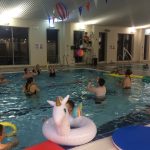The Lighthouse Poole, Mezzanine Gallery and Lees Gallery, BU Talbot campus are currently exhibiting artwork about Bournemouth-based Communi-T members’ past and present experiences of swimming and aquatic activity. The art materials, swim sessions and accompanying research were funded through a combination of British Academy, Leisure Studies Association and Bournemouth University. The exhibitions include professionally drawn illustrations, drawings from Communi-T members and their words spoken during interview and focus group research.
The research found that exclusive use of the BHLive swimming pool facility at Pelhams in Bournemouth provided positive opportunity for transgender participation; participation benefited individual’s wellbeing. The project is based on 14 months of monthly 1-hour swimming sessions. The sessions – funded by various sources – enabled private hire of the pool.
For members of the group their previous experiences of visiting a swimming pool caused a number of difficulties, especially the use of changing rooms and what to wear in the water. They often felt intimidated by public pools. Many reported feeling fearful and that they would be excluded simply because they are transgender.
“I remember how terrified I was, how afraid I was of being judged … of anybody discovering that I was pre-op. I understand why any trans person would not want to go near a public pool because everything about it tends to be binary gendered.”
Common feelings before the swim sessions included feeling anxious, nervous, stressed, self-conscious, dysphoria, awkward, worried and excited. Being in the water meant that many of the group felt liberated and afterwards felt: happy, content, relaxed, confident, healthy, body confident, refreshed, peaceful, energised and motivated to do more exercise.
“Having the session gives me confidence and is fun and relaxing and allows me to connect with the water.”
“Even though I’m just splashing around, it is good fun. It reminds me of being a kid. We used to go when I was a kid and we used to splash about. I look forward to it.”
“It gives me a chance to interact with other people … And, it’s also fun! Right!”
“It put me in a really good mood. I was knackered. It made me feel good.”
One of the main findings from the project is that the opportunity to have exclusive use of a pool means that group members felt safe, especially as they transition. For transgender, and non-binary, people this feeling of safety is paramount to physical activity participation.
“It’s all about having a safe space. Knowing that no one is there to judge us that we’re not going to get stared at. You just know that it’s going to be completely safe and you’re going to be completely accepted”.
“I nearly did it as a sport when I was younger and then I came out and didn’t swim again. I tried it one time before our swimming group and was like: ‘never doing that again’. I was wearing a waterproof tank top designed for a pool. A lifeguard came over and said: ‘why are you wearing that in the pool?’ I actually just outed myself: ‘I’m transgender, this is the only way I can swim’ … I decided it wasn’t a safe space. But, now, it’s a really nice way for me to swim [with the group].”
Lighthouse, Poole Exhibition: Art Event Flyer-4
Curator: Rochelle Gough
Researchers: Jayne Caudwell & Carly Stewart
 Photo of the week ‘Safe swim: Supporting physical activity and well being for transgender young people’
Photo of the week ‘Safe swim: Supporting physical activity and well being for transgender young people’










 Final Bournemouth University publication of 2025
Final Bournemouth University publication of 2025 On Christmas Day in the Morning…
On Christmas Day in the Morning… New Nepal scoping review on maternal & neonatal health
New Nepal scoping review on maternal & neonatal health Fourth INRC Symposium: From Clinical Applications to Neuro-Inspired Computation
Fourth INRC Symposium: From Clinical Applications to Neuro-Inspired Computation ECR Funding Open Call: Research Culture & Community Grant – Application Deadline Friday 12 December
ECR Funding Open Call: Research Culture & Community Grant – Application Deadline Friday 12 December MSCA Postdoctoral Fellowships 2025 Call
MSCA Postdoctoral Fellowships 2025 Call ERC Advanced Grant 2025 Webinar
ERC Advanced Grant 2025 Webinar Horizon Europe Work Programme 2025 Published
Horizon Europe Work Programme 2025 Published Horizon Europe 2025 Work Programme pre-Published
Horizon Europe 2025 Work Programme pre-Published Update on UKRO services
Update on UKRO services European research project exploring use of ‘virtual twins’ to better manage metabolic associated fatty liver disease
European research project exploring use of ‘virtual twins’ to better manage metabolic associated fatty liver disease